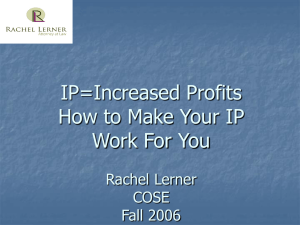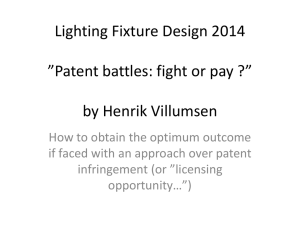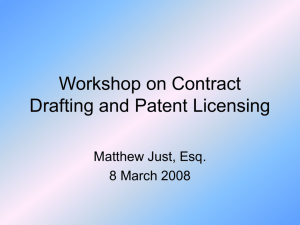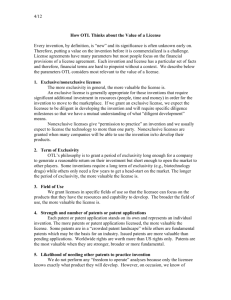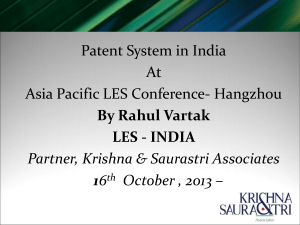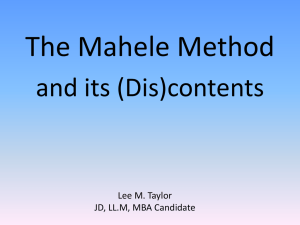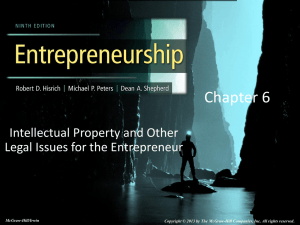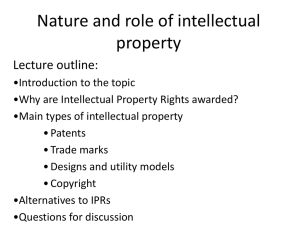Charles Timoney - London IP Summit
advertisement
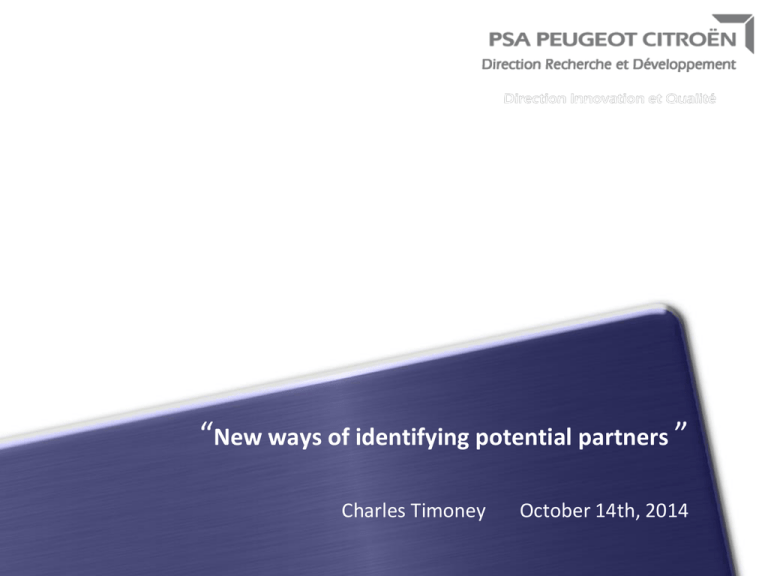
“New ways of identifying potential partners ” Charles Timoney October 14th, 2014 – INTRODUCTION Having decided to enter into an active licensing programme, you are faced with the problem of how to identify potential partners and how to contact them. I propose to examine some, hopefully, new ways of identifying potential partners. 2 – NEW WAYS OF IDENTIFYING POTENTIAL PARTNERS (1) “Inventor of the Month” awards: - A good opportunity to obtain valuable commercial information from the inventor himself, or his superiors, which may enable possible partners to be identified. 3 - NEW WAYS OF IDENTIFYING POTENTIAL PARTNERS (2) Your own supplier of patented products: - If the product in question is not strategic, you can offer a license to your own supplier in order to allow him to broaden his market. - In some cases, this may also reduce the product price to your company in view of the higher production quantites. - It is important that your database shows those patents which are exploited for your company by outside suppliers. 4 - NEW WAYS OF IDENTIFYING POTENTIAL PARTNERS (3) Provide a procedure for the payment of a bonus for infringement detection: - A bonus is payable to any person (inventor or not) who detects an infringement by a third party of one of your company’s patents. - The infringement has to be confirmed by the IP department; - An approach can then be made to the infringer, offering a license; - The bonus is paid, even when no approach is made to the infringer 5 - NEW WAYS OF IDENTIFYING POTENTIAL PARTNERS (4) Patents destined to be abandoned: - Some patents in specific fields, which are no longer of interest to the company and are therefore destined to be abandoned, might nevertheless be of interest to third parties; - For such patents, possible licensees can be identified by checking those patents against which your patent has been cited (preferably in category X or Y); - This only really applies to groups of patents; - Offer them to potential partner, explaining that they relate to a field which you know to be of interest to them; 6 - NEW WAYS OF IDENTIFYING POTENTIAL PARTNERS (5) “Citing patents”: - This idea makes use of external databases to identify potential licensees; - Select your own patent portfolio in the database (eg Orbit); - Select those third-party patents against which any of your patents have been cited as X or Y; - Collate these third-party patents by Applicant, and then in order of quantity; - Contact the companies in question 7 TO WHOM SHOULD YOU SEND YOUR OFFER? - Ideally, to the IP specialist who deals with Licensing; - Identify him from lists of Patent Specialists; - Or from the representative shown on published patents (or via their Patent Attorneys); - Lists of members of societies such as LES 8 WHO ELSE SHOULD YOU SEND YOUR OFFER TO? - The corresponding person to your Technical Expert; - Your Technical Expert may be able to identify a suitable contact person; - This gives a “two-pronged” approach which may be more effective 9 WHAT DO YOU SEND TO THE POTENTIAL LICENSEE? - Nothing which could be construed as being a threat; - At least the patent (in an appropriate language); - An indication of how the invention may be of interest; - Commercial and technical information where available; - Details of the actual device, if available 10 WHAT ELSE MIGHT BE USEFUL FOR THE POTENTIAL LICENSEE? - The potential advantages for him in using your IP; - It is important to look at the IP from the potential licensee’s point of view 11 SELLING THE PATENT(S) - 1 - In some situations, it can be advantageous to transfer ownership of the patent(s) rather than make it the subject of a license agreement 12 SELLING THE PATENT(S) - 2 Possible reasons for a sale: - The projected royalties are too small; - The two companies are of widely different sizes; - There is only one patent in question; - The parties have been unable to reach agreement on the terms of the License; - The Licensee needs an exclusive license but is unwilling to pay the higher fees 13 LICENSE MANAGEMENT – (1) - Your in-house patent database should indicate that a patent is the subject of a license; - This ensures that the patent is not inadvertently abandoned; - The database has to be kept up to date 14 LICENSE MANAGEMENT – (2) - It is useful to have a database for Contracts; - Ideally, this should store each successive version of the contract 15 LICENSE MANAGEMENT – (3) - The Licensor has to obtain the correct annual sales figures from the Licensee, or, alternatively: - The Licensee has to provide the correct annual sales figures to the Licensor – this is not always easy; 16 LICENSE MANAGEMENT – (4) - The Licensor has to determine to which budget the royalties are to be credited; - The Licensee has to determine which budget will be responsible for paying the royalties; – This is not always easy! 17 Any questions? 18
